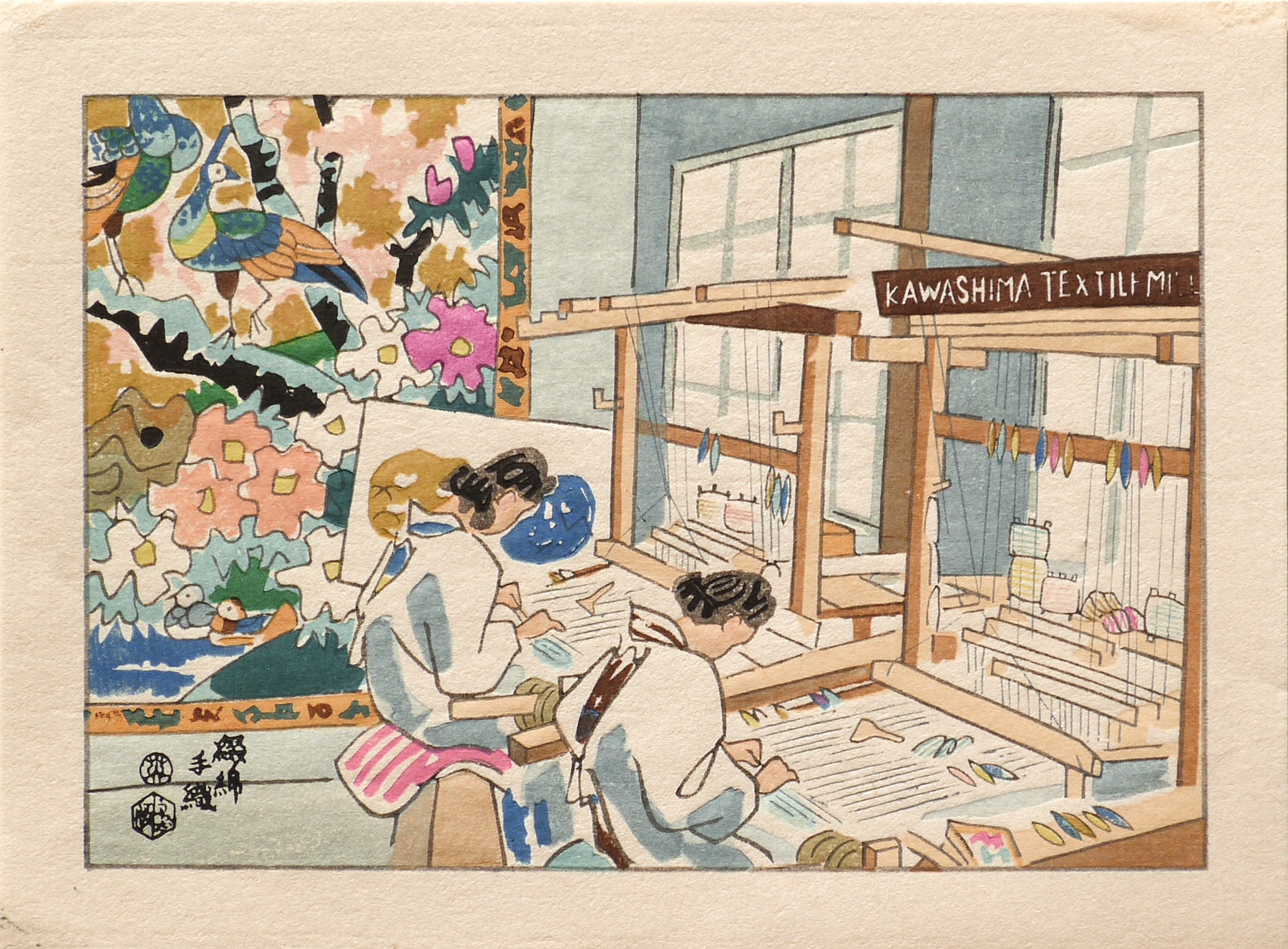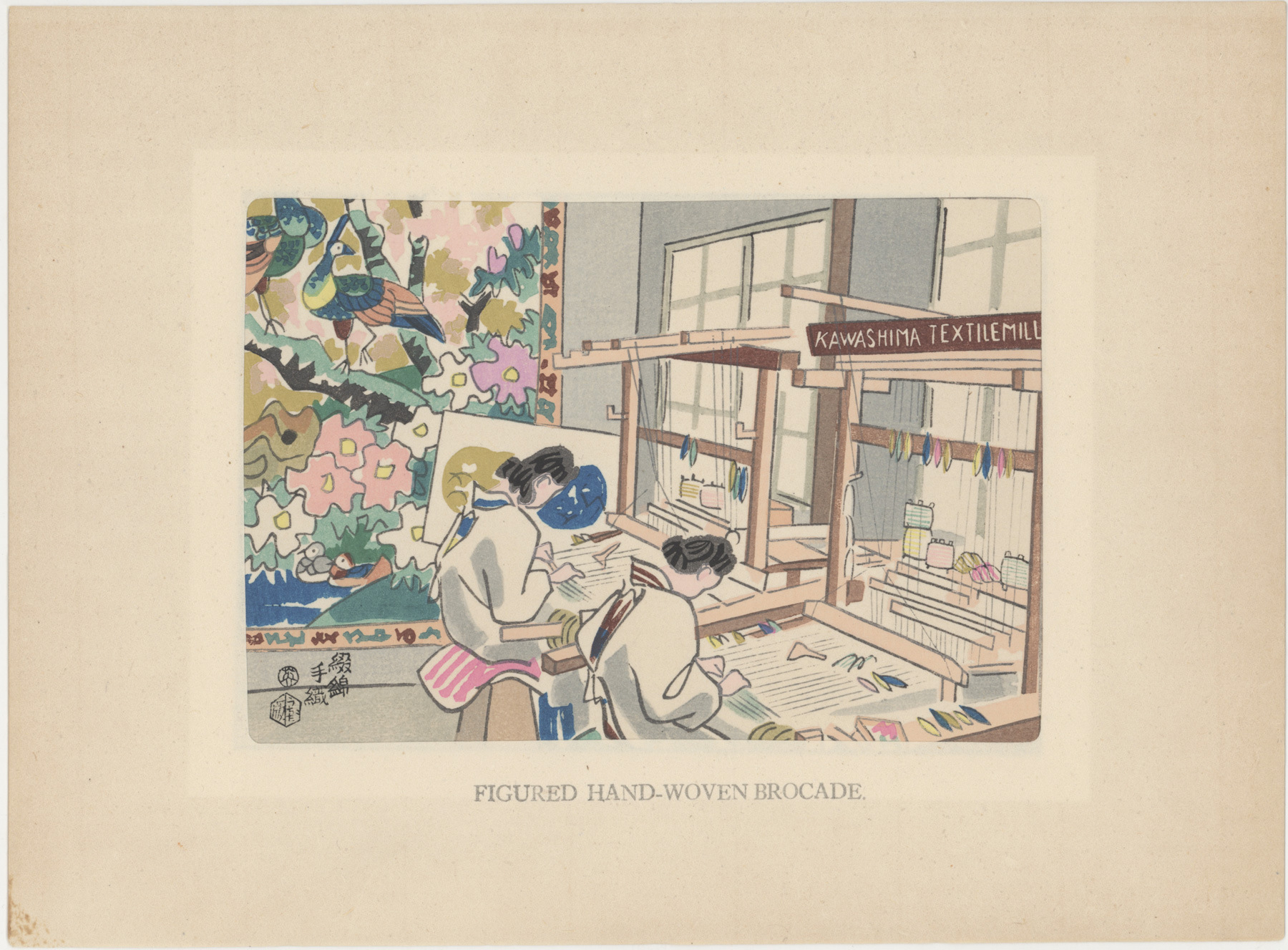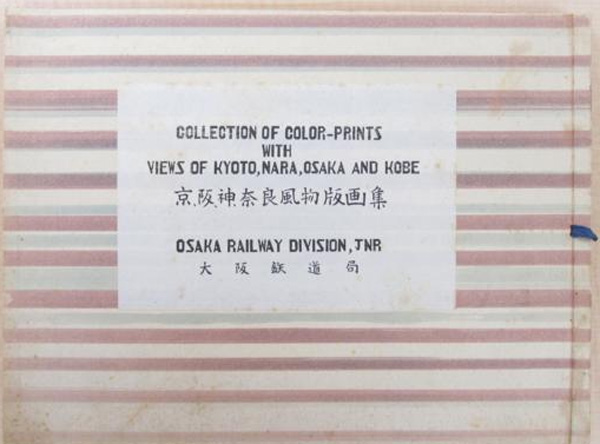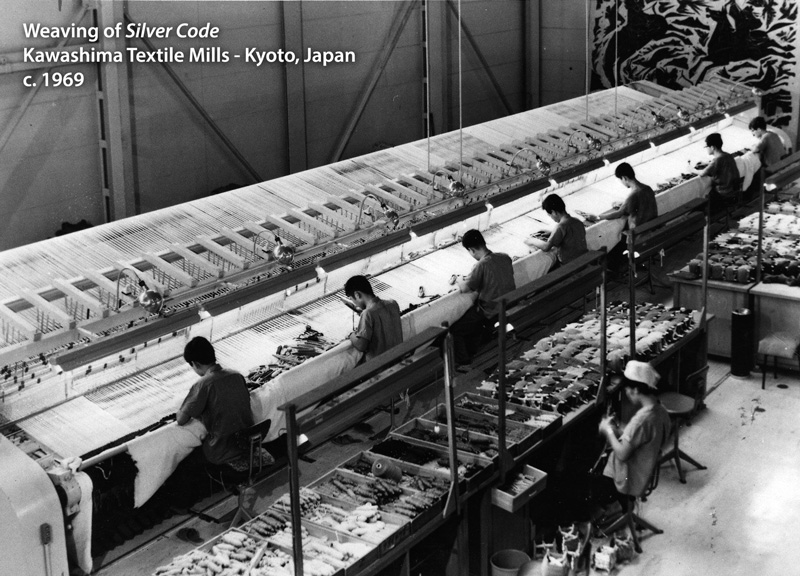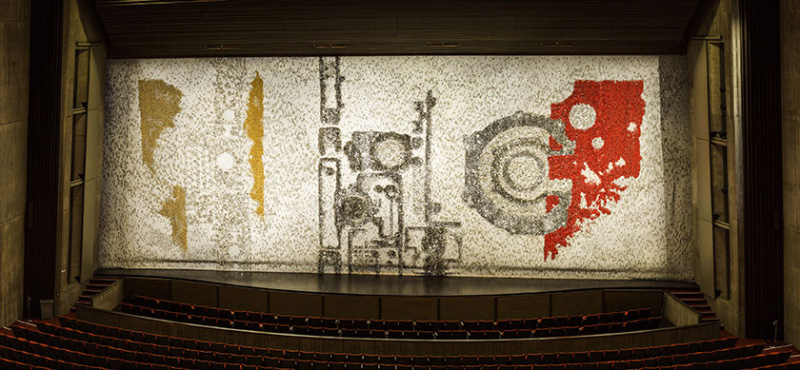About This Print
This small print depicts weavers at Kawashima Textiles with one of their beautiful large tapestries in the background. Originally I thought this print might have been commissioned by Kawashima Textiles as a promotional piece after they changed their name from Kawashima Textile Organization in 19571, but it turns out it is part of a portfolio of prints offered by the Osaka Railway Division, Japanese National Railways titled Collection of Color-Prints with Views of Kyoto, Nara, Osaka and Kobe.The table of contents for the portfolio states:
FIGURED HAND-WOVEN BROCADE.
Traditional Nishijin, fabric of Kyoto is gorgeous brocade hand-woven with finger-tips.
Also see this collection's print Pottery Works, Higashi-Honganji, Nakanoshima Park and Maiko Park from the same portfolio.from the same portfolio.
Kawashima Textiles
Source: website of LIXIL Group Corporation http://www.lixil-group.co.jp/e/special_topics/01.htm
The mill, located in Kyoto, has a history of producing some of the world's finest modern tapestries and its origins can be traced to 1843, when Kawashima Jimbei (1819-?) opened his fabrics store in Kyoto. The development of the weaving business is credited to his son, also named Jimbei, who built a mill to produce fine textiles and was to become known as the "Father of original Japanese weaving, tsuzure." In 1887, Jimbei received a special order for the production and delivery of decorative fabrics for the Meiji Imperial Court, the first order of its kind in Japan for decorative fabrics for the Imperial Household.
Associated with the mill is the Kawashima Textile School.
The production of Silver Code, a historic stage curtain measuring 80 x 35 feet,
in use at the Stephens Auditorium at Iowa State University, which has
recently [2013] undergone a meticulous restoration.
Designed by artist and sculptor Ryokichi Mukai (Japanese, 1918-2010),
the curtain – a true work of art – was named Giniro-no-kigou translated as Silver Code.
Largely an expression of abstract symbolism, Silver Code expresses the
sciences and technology at Iowa State.2
Silver Code
1 In 2006, the company merged with Selkon Co. Ltd., a company founded in1914 as a specialty lace shop that supplied interior fabrics like curtains andcushions. This merger marked the inception of Kawashima Selkon Textiles Co.Ltd. (Source: http://www.lixil-group.co.jp/e/special_topics/01.htm)
2 website of Iowa State University http://www.museums.iastate.edu/Curtain.html
Source: Ashmolean Museum: Threads of Silk and Gold: Ornamental Textiles from Meiji Japan
Tapestry Weaving. http://www.ashmolean.org/assets/docs/Exhibitions/AshmoleanThreadsPressKit.pdf
Weaving was the oldest technique used to create patterned textiles for the elite in Japan, with Kyoto at the centre of production. Particularly admired abroad during the Meiji era were nishiki silk ‘brocades’. One type of nishiki was tsuzure-ori or tapestry weave. This was a laborious, time-consuming process, with some of the more elaborate pieces made by top producers like Kawashima Jinbei in Kyoto taking as long as five or six years to make. The Meiji period saw great changes in the weaving industry with the introduction of mechanised looms and loom attachments from Europe.
To such masterly perfection has this art been carried that any picture can be reproduced in weaving, especially in that kind of weaving for which Kyoto artisans are celebrated, namely, the ‘tsuzuri-ori’, in which all the chiaroscuro, all the delicacy of touch or boldness of stroke of the original picture, are faithfully reproduced at will with threads...
Count Shigenobu Okuma, Fifty Years of New Japan, 1909
Print Details
| IHL Catalog | #989 and #1666 |
| Title | Kawashima Textile Mills (as printed in English on image), 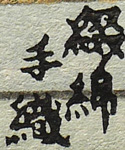 (Note: the original folder in which this print was issued carries the title "Figured Hand-Woven Brocade".) |
| Series | Collection of Color-Prints with Views of Kyoto, Nara, Osaka and Kobe 京、阪、神、奈良風物版画集 |
| Artist | Kotozuka Eiichi (1906-1979) |
| Signature | not signed |
| Seal |  |
| Date | c. 1957 |
| Edition | likely first and only |
| Publisher |  版元 うちだ Hanmoto Uchida Uchida Bijutsu Shoten 内田美術書店 and Osaka Railway Division, JNR 大阪鉄道局 [Marks: pub. ref. 558; seal not shown] |
| Impression | excellent |
| Colors | excellent |
| Condition | excellent |
| Genre | shin hanga (new print) |
| Miscellaneous | |
| Format | yotsugiri (half-chuban) |
| H x W Paper | IHL Cat. #989: 5 1/8 x 6 7/8 in. (13 x 17.5 cm) IHL Cat. #1666: 4 13/16 x 6 5/8 in (12.2 x 16.8 cm) |
| H x W Image | IHL Cat. #989 and #1666: 4 1/8 x 5 15/16 in. (10.5 x 15.1 cm) |
| Collections This Print | Osaka Municipal Library f0005001 |
| Reference Literature |


